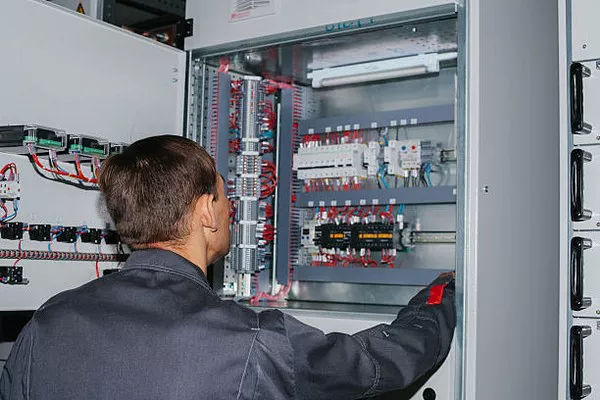Transformers are fundamental components in electrical engineering, enabling efficient transmission and distribution of electricity across power grids worldwide. These devices operate on the principles of electromagnetic induction and play a crucial role in voltage regulation and power transformation. In this article, we will delve into the workings of transformers, their types, applications, and significance in modern electrical systems.
Basics of Transformers
A transformer is an electrical device that transfers electrical energy between two or more circuits through electromagnetic induction. It consists of two main components: primary winding and secondary winding, both wound around a magnetic core. The primary winding is connected to the input voltage source, while the secondary winding is connected to the load. When an alternating current (AC) flows through the primary winding, it generates a magnetic field in the core, which in turn induces a voltage in the secondary winding.
The key principle governing transformer operation is Faraday’s Law of Electromagnetic Induction. According to this law, a change in magnetic flux through a coil induces an electromotive force (EMF) or voltage in the coil.
Working Principle
Transformers operate based on the following principles:
Mutual Induction: When an alternating current flows through the primary winding, it produces a changing magnetic field in the transformer’s core. This changing magnetic field induces a voltage in the secondary winding through mutual induction.
Turns Ratio: The ratio of the number of turns in the primary winding (𝑁1N1) to the number of turns in the secondary winding (𝑁2N2) determines the voltage transformation ratio (𝑉1/𝑉2V1/V2). This ratio governs how the voltage is stepped up or stepped down based on the application.
Conservation of Energy: Ideally, a transformer conserves power, where the input power (VI) is equal to the output power (VI) neglecting losses.
Types of Transformers
Transformers are classified based on their purpose, construction, and usage:
Step-Up Transformers: These transformers increase the voltage level from the primary to the secondary winding, used primarily in power transmission.
Step-Down Transformers: Conversely, these transformers decrease the voltage level, making them suitable for distribution networks and consumer applications.
Isolation Transformers: They are used for isolating two circuits electrically while transferring power from one circuit to another.
Auto Transformers: These have a single winding tapped at various points, offering a variable turns ratio and are used for voltage regulation.
Transformer Components
Core: Typically made of laminated steel to minimize eddy current losses and hysteresis losses.
Windings: Primary and secondary windings are insulated copper wires wound around the core. The number of turns in each winding determines the voltage ratio.
Insulation: Insulating materials like varnish or enamel are used to prevent short circuits between windings and the core.
Tap Changer: A mechanism used to adjust the turns ratio, facilitating voltage regulation.
Applications of Transformers
Transformers are indispensable in various sectors of electrical engineering:
Power Transmission: They step up the voltage for efficient long-distance power transmission, minimizing losses.
Power Distribution: Step-down transformers reduce high-voltage electricity to safer levels for distribution to homes and industries.
Industrial Applications: Transformers power heavy machinery, providing the necessary voltage and current levels.
Electronics: Small transformers are used in electronic devices for voltage regulation and isolation.
Importance in Power Systems
Transformers play a crucial role in modern power systems for several reasons:
Efficiency: They enable efficient energy transfer by reducing losses during transmission and distribution.
Voltage Regulation: Transformers maintain stable voltage levels, critical for the reliable operation of electrical equipment.
Isolation: They isolate different parts of the power system, improving safety and preventing ground faults.
Adaptability: Transformers allow voltage levels to be adapted to suit different applications and loads.
Transformer Losses
While transformers are highly efficient, they are not entirely lossless. The main losses in transformers include:
Copper Losses (I²R Losses): Result from the resistance of the windings, proportional to the square of the current.
Iron Losses: Arise from hysteresis (energy lost due to magnetizing and demagnetizing the core) and eddy currents (localized circulating currents).
Stray Losses: Occur due to leakage flux and imperfect magnetic coupling.
Efforts are made in transformer design and operation to minimize these losses and enhance overall efficiency.
Future Trends
In the evolving landscape of electrical engineering, transformers continue to adapt and improve:
Smart Grid Integration: Transformers are being equipped with sensors and monitoring devices for real-time data collection and remote control.
High-Voltage Direct Current (HVDC) Transmission: HVDC systems are incorporating advanced converter transformers for efficient long-distance power transmission.
Energy Efficiency: Research is focused on developing transformer materials with reduced losses to enhance overall system efficiency.
See Also Isolation Transformers: Applications, Benefits & Considerations
Conclusion
Transformers are foundational components of electrical engineering, enabling the efficient generation, transmission, and distribution of electrical power. They operate on the principles of electromagnetic induction, providing voltage transformation and regulation essential for diverse applications. As technology advances, transformers continue to evolve, incorporating smart features and improved materials to meet the demands of modern power systems. Understanding the principles and applications of transformers is essential for engineers and practitioners in the field of electrical engineering as we strive towards more sustainable and efficient energy systems.

